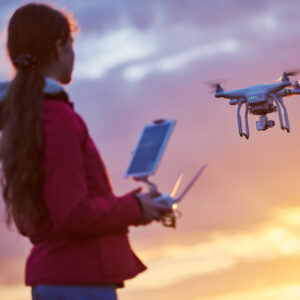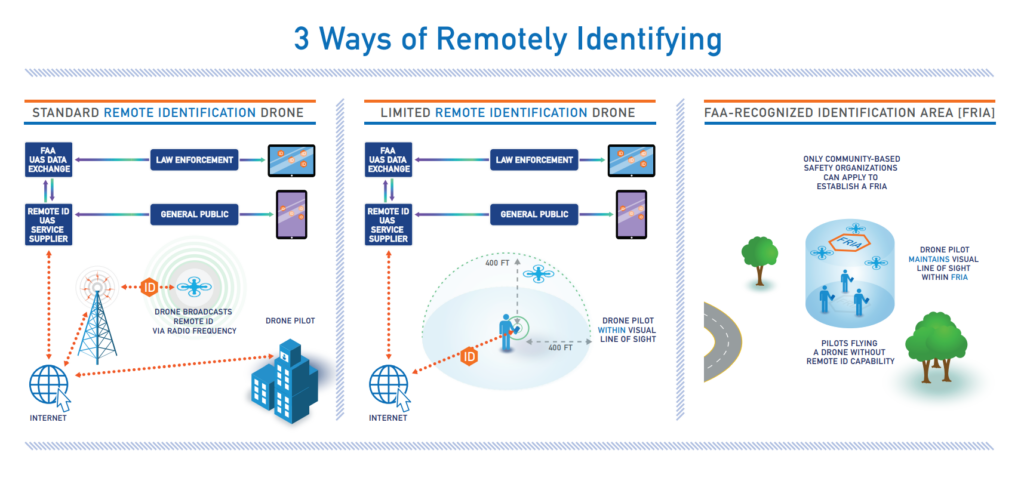 On December 31, 2019, the FAA published a notice of proposed rulemaking (NPRM) to establish a remote identification system for unmanned aircraft systems (UAS) flights. Remote identification can help to safely integrate UAS into the national airspace system (NAS). The rules would apply to nearly all drones weighing more than 0.55 lbs, including UAS flown for recreation and commercial operations.
On December 31, 2019, the FAA published a notice of proposed rulemaking (NPRM) to establish a remote identification system for unmanned aircraft systems (UAS) flights. Remote identification can help to safely integrate UAS into the national airspace system (NAS). The rules would apply to nearly all drones weighing more than 0.55 lbs, including UAS flown for recreation and commercial operations.
If enacted, the drone community should expect the implementation of tracking and management of nearly all UAS flights by the FAA within the next three years. The proposal has received significant attention from the public, attracting around 100,000 views and 1,000 comments within the first three days of its release, voicing a mix of support and disapproval. The public is invited to continue submitting comments until March 2, 2020, which will be used to inform the drafting of new rules.
According to the FAA, the need for identification and tracking of drones and their operators is due to the rise of reckless use of drones. In recent years, drones have been instrumental in criminal operations that involve smuggling, distribution of hate speech, and disruption of airport operations. So far, many of these reckless operations have been hiding in the blind spot of authorities. With this new proposal, the FAA looks to reestablish the long arm of the law and keep the public safe from harm, injury, and encroachment, while making it accessible for drone operators to comply with the new rules. According to the NPRM,
Remote identification would also aid in preventing terrorist attacks. Recent reports in the news, including the Islamic State of Iraq and Ash-Sham’s modifications of commercial UAS, the assassination attempt of Nicolás Maduro in Venezuela, a foiled plot in the United Kingdom to fly an unmanned aircraft into an airliner, and a bomb-laden unmanned aircraft flown by Huthi forces and detonated over a military parade in Yemen, illustrate the ways in which UAS may be used to threaten life, critical infrastructure, and national security. Remote identification of UAS would enable national security agencies and law enforcement to quickly identify potential threats and act to prevent such incidents.
The NPRM includes 3 levels of remote identification:
-
Standard
-
Limited
-
None: FAA-Recognized Identification Area (FRIA)
According to the proposed rules, Standard Remote Identification requires
- The broadcast of identification and location information directly from a given unmanned aircraft and
- The simultaneous transmission of that data to a Remote ID UAS Service Supplier (USS) through an internet connection.
Within this remote identification category, operators may be allowed additional privileges, such as flights beyond visual line of sight (BVLOS) without a waiver and other advanced operations the FAA expects to approve. The agency estimates that 93 percent of drones currently registered under Part 107 either already comply with the Standard Remote Identification requirements or can be easily retrofitted with a software update.
Limited Remote Identification requires only transmission of identification and location information through the internet, with no broadcast requirements directly from the aircraft. Operations are additionally limited to no more than 400 feet from the control station in any direction.
 With these identification methods, every unmanned aircraft can be quickly identified by other users and law enforcement, who will have access to each aircraft and pilot’s location.
With these identification methods, every unmanned aircraft can be quickly identified by other users and law enforcement, who will have access to each aircraft and pilot’s location.
Operators who are unwilling to participate or own drones that weight more than 0.55 lbs and are unable to comply with the requirements are only allowed to fly in FAA-Recognized Identification Areas (FRIA) and must maintain line-of-sight throughout the flight. FRIAs include such locations as flying sites sanctioned by the Academy of Model Aeronautics.
Within the comments of the proposal, the public’s greatest cause for concern is privacy: How will the location of operators will be made available? Under the Standard level of remote identification in the proposed Part 89, drones are required to transmit a unique identification number, GPS location data, and the barometric altitudes of both the drone and pilot. While law enforcement will have access to all of the available information, the FAA is allowing UAS Service Suppliers like DJI to determine how customer information will be distributed at the network level. According to the proposal, “The FAA anticipates that there will be some Remote ID USS available to the general public and that others will be private.” This is vague, but it is early in the process.
We invite you submit your comments to the FAA by visiting the NPRM website. Gleim will continue to monitor developments and provide updates as they become available.
If you would like to learn more about Remote Pilot Operations and how to legally fly your drone, Gleim can help you become an FAA-certificated Remote Pilot. Our training materials provide everything you need know to pass the certification test with simple step-by-step instructions, illustrations, and study guides.
Written by Ryan Jeff, AGI, Gleim Aviation Research Assistant


